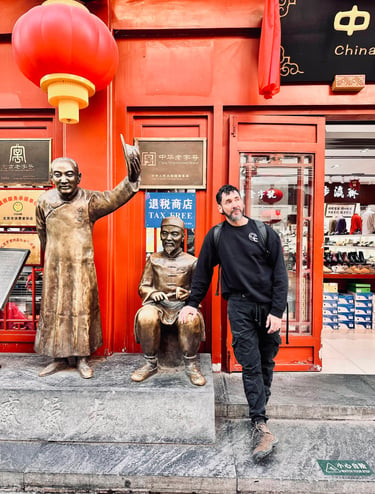Beijing #2
Travelblog #2
TRAVEL
In the first part, I talked about censorship, surveillance, and my first impressions. Now, it’s about my personal highlights. You’ve probably heard countless times that the Forbidden City, the Great Wall, and other landmarks are impressive. Of course, they’re worth visiting, but I want to focus on what you rarely hear about—the things that made Beijing special for me.
First Impressions
Already on the way from the airport to the hotel, I noticed something unexpected: the air was clear—no smog, no thick haze, just blue skies. During my eight days in the city, I didn’t see or smell a single gasoline-powered car. Beijing has fully embraced electric vehicles, and the difference is huge—not just for the air quality but also for the overall atmosphere of the city. The transformation started in the 2000s, with public transportation shifting to electric, and by the 2010s, factories responsible for heavy smog were either relocated or shut down.
The People
They were also different from what I had expected—friendly, helpful, and above all, relaxed, which is unusual for a city of 22 million people. One of the first things I noticed in my hotel was the number of jobs that don’t exist in Germany. Door openers or elevator attendants—people whose entire job is to hold doors open or press elevator buttons for guests. And not just in hotels, but also in shopping malls. No one seemed annoyed or frustrated, even though it’s a repetitive task. These jobs emerged in the 1980s when China opened up to the West and the economy began to grow. As urbanization progressed rapidly, simple jobs were created to prevent unemployment. Many of these roles still exist today and help people from rural areas integrate into the city. At the same time, they provide a level of personal service that has almost disappeared in Western countries.
The Cityscape and the Question of Control
Beijing is a mix of modern skyscrapers, historical landmarks, and hutongs—narrow alleyways with traditional courtyards. Many of them are protected as cultural heritage sites, similar to old half-timbered houses in Germany. While new high-rises continue to be built, the hutongs remain, ensuring that this blend of old and new will continue to shape the city’s character in the future.
What stood out to me the most: Beijing is one of the cleanest cities I have ever visited. No litter, no graffiti, no vandalism. There are no neglected areas or overflowing trash cans. Even at night, the city felt safe. Of course, this is also due to the extensive surveillance. Cameras are everywhere, and there is little room for anonymity in public spaces. While in Europe, this level of monitoring is seen as a significant invasion of privacy, in China, it’s barely questioned. The question is: would a certain level of control also make sense for us? In Western cities, vandalism, pollution, and crime are ongoing issues, and solutions often seem ineffective. In Beijing, the system works—the city is safe, clean, and well-organized.
I’m not saying that constant surveillance is the answer. But the reality in Beijing shows that it produces results. The question remains: how much control is necessary to make a city livable? And where do we draw the line between security and freedom?
The Food
Food in most Asian countries is more than just nourishment—it’s a communal experience. While in the West, everyone orders their own dish, in Asia, meals are meant to be shared. Dishes are placed in the center, everyone takes from everything, and eating is an integral part of social life. This cultural importance is reflected in the cityscape as well. Restaurants, markets, and food stalls are everywhere. While Western cities often separate residential, business, and shopping areas, in Asia, everything happens at the same time in the same space. Another key difference is the Michelin presence. In Asia, Michelin-starred restaurants aren’t just high-end fine dining—many affordable street food stalls and small eateries have earned Michelin recognition as well. In Europe, Michelin restaurants are usually expensive, with tiny portions on oversized plates. In Asia, you can get top-quality food for just a few euros and actually leave feeling full. If you’re unsure where to eat, I recommend using the Michelin app, which doesn’t just highlight luxury restaurants but also many budget-friendly, high-quality street food spots.
Progress
Beijing is technologically impressive. Everything operates digitally, and even people over 80 use smartphones as if it were the most natural thing in the world. Whether they’re watching Douyin (China’s TikTok) or paying for the metro with their phone, there’s no hesitation when it comes to modern technology. This contrast is especially noticeable in public transportation. In Beijing, you simply scan a QR code on your phone to enter the metro—no paper tickets, no vending machines, no complicated fare zones. In Germany, on the other hand, there’s still debate over whether the Deutschlandticket should also be available in paper form so that older people can use it. Instead of focusing on how to introduce people to digital solutions, the discussion revolves around how long outdated systems should continue to exist.
And this raises a fundamental question: Is it better to push society toward new technology, or, like in Europe, to maintain alternatives for those who resist change? In Beijing, there is no choice—you have to adapt. But because of that, there is no digital divide. While many older people in Germany struggle with apps and QR codes, in China, everyone seamlessly uses digital tickets without giving it a second thought.
What Stood Out the Most
One thing that really stood out to me: there were no delays. Whether it was the metro, buses, or taxis—everything was on time. The metro runs every few minutes, buses stick to their schedules, and Didi taxis were always available within minutes. In Germany, delays are just part of daily life, but in Beijing, it doesn’t even seem to be an issue.
Crowds and Best Time to Visit
Beijing can be unbearably hot in the summer, with temperatures over 35°C and high humidity. I visited in November, and the weather was perfect—between 2°C and 20°C. The city felt relaxed, attractions weren’t overcrowded, and I always found a seat on public transport. If you want to avoid crowds, traveling outside peak seasons is the way to go. The busiest times are during the summer holidays (July/August), National Day (October 1st), and the Chinese New Year (January/February). Since November 30, 2024, German citizens, among others, can travel to China visa-free for up to 30 days. This regulation is in effect until at least December 31, 2025.
Matze’s Final Travel Tip – Keeping It Short This Time: Book a trip to Beijing 😊… stay tuned…





